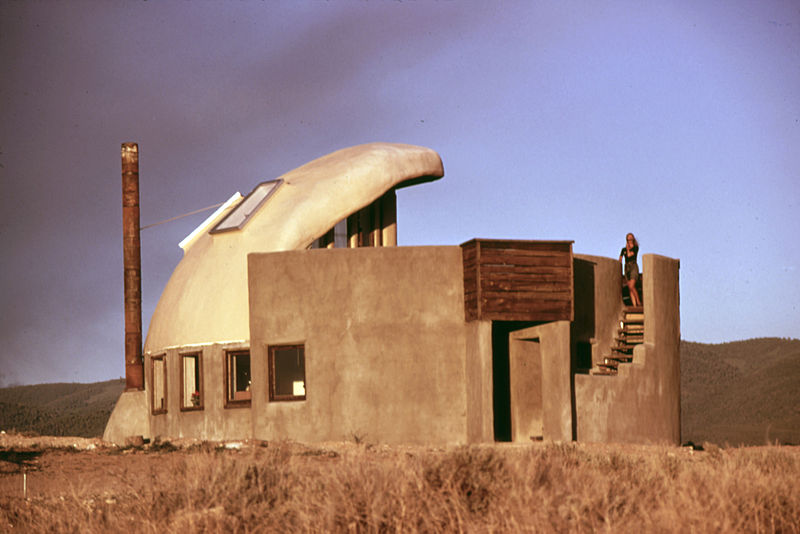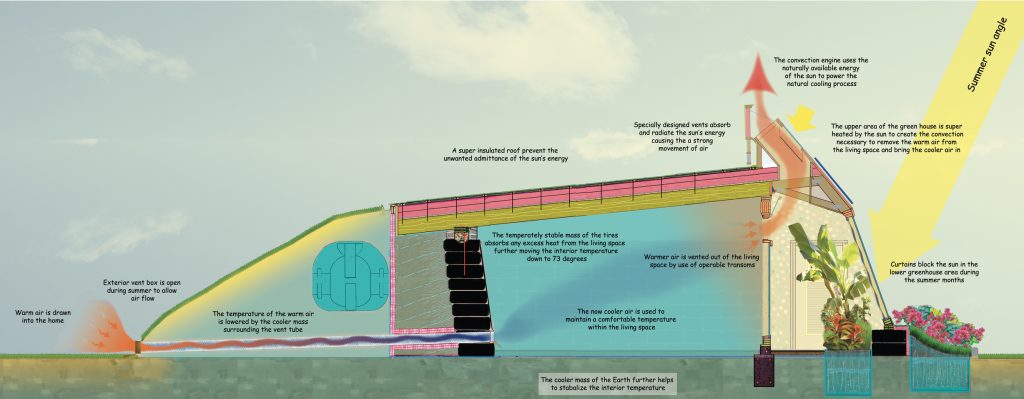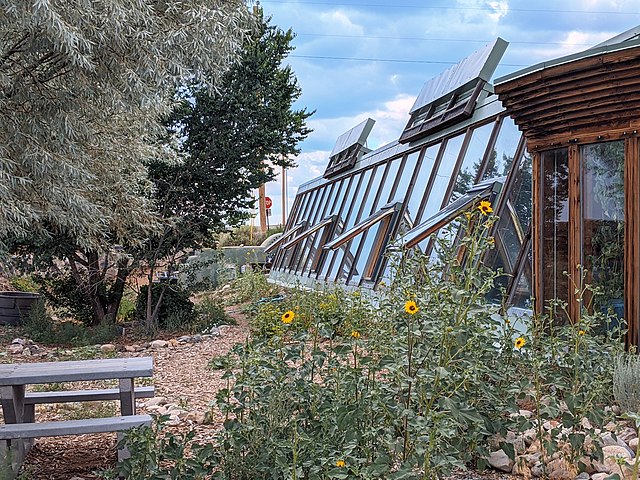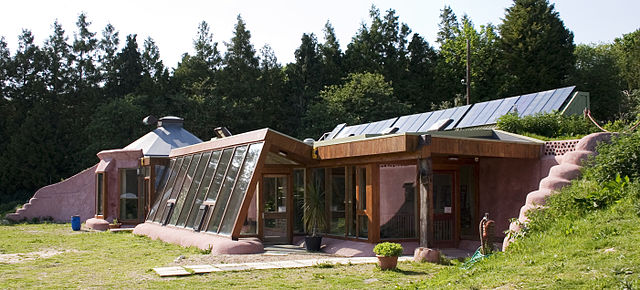Earthships

Earthships
L'une des premières approches “nouvel Age” pour une configuration durable hors réseau. Michael E. Reynolds, l'esprit originel derrière l'idéal, a consacré une bonne partie de sa vie à cette. Il est un partisan de “vie radicalement durable”. Often has he been a critic of the profession of architecture for its adherence to conventional theory and practice.
He advocates the reuse of unconventional building materials.
Le concept d'architecture Earthship a commencé à prendre forme dans les années 1970.
Designt to be build with very low skill-level and to work in all enviroments.
Consultez sa chaîne YouTube pour de nombreuses très bonnes ressources vidéo sur la façon de construire, quels matériaux utiliser, etc.
https://www.youtube.com/user/earthship/videos
https://en.wikipedia.org/wiki/Mike_Reynolds_(architect)
https://en.wikipedia.org/wiki/Earthship
Earthship devrait être considéré comme une source d'inspiration pour tous ceux qui vont OffGrid.
Eco friendly in about any way possible. Suitable for all enviroments.

Earthships are predicated upon the idea that there are six human needs which can be addressed through environmentally sustainable building design:
- Énergie: Thermal and/or solar heating and cooling, solar and wind electricity
- Garbage management: Reuse and recycling built into construction and daily living
- Sewage treatment: Self-contained sewage treatment and water recycling
- Shelter: Building with natural and recycled materials
- Clean Water: Water harvesting and long term storage
- Aliments: In-home organic food production capability
.
The buildings are often horseshoe-shaped due to the difficulty of creating sharp 90 degree angles with rammed tires. In Reynolds’s prototype at Taos, the opening of the horseshoe faces 10–15 degrees east of south to maximize natural light and solar-gain during the winter months, with windows on sun-facing walls admitting light and heat.
The book, Earthship I, describes how to find the best angle depending on the building’s geographic location. The thick and dense walls provide thermal mass that naturally regulates the interior temperature during both cold and hot outside temperatures. The outer walls in the majority of Earthships are made of earth-rammed tires, but any dense material with a potential to store heat, tel que concrete, adobe, earth bags, or stone, could in principle be used to create a building similar to an Earthship. The tire walls are staggered like traditional brick work, and often have “concrete half blocks” every other course, to equal the length of the staggered tire below. In an effort to cut down the use of concrete even further, they also use “squishies” – tires rammed in between a tight space to even out the course or to compensate for varying tire size.

.
The rammed earth tires of an Earthship are assembled by teams of two people. One person shovels dirt and places it into the tire one scoop at a time. The other person, who stands on the tire, uses a sledgehammer to pack the dirt in while moving in a circle around the tire to keep the dirt even and to avoid warping the tire. Rammed earth tires can weigh up to 300 lb (140 kg), so they are typically filled in place. Because the tire is full of soil, it does not burn when exposed to fire. In colder climates, extra insulation is added on the outside of the tire walls.
Tires rammed with earth and stacked
On top of the tire walls are either “can and concrete bond beams” made of recycled cans joined by concrete, or wooden bond beams with wooden shoes. These are attached to the tire walls using concrete anchors, poured blocks of concrete inside the top tires. Wooden shimming blocks placed on top of the wooden bond beam make up the wooden shoes. The wooden bond beam consists of two layers of lumber bolted on to the concrete anchors. Re-bar is used to “nail” the wooden shoes to the wooden bond beam.
Internal, non-load-bearing walls are often made of a honeycomb of recycled cans joined by concrete; these are nicknamed tin can walls. These walls are usually thickly plastered with adobe, and resemble traditional adobe walls when finished.
The roof is made using trusses, or wooden support beams called vigas, that rest on the wooden shoes or the tin can walls placed on the bond beams. The roof as well as the north, east and west facing walls are heavily insulated to reduce heat loss.
.
Earthships are designed to catch all the water they need from the local environment. Water used in an Earthship is harvested from rain, snow, and condensation. As water collects on the roof, it is channeled through a silt-catching device and into a cistern. The cisterns are positioned to gravity-feed a water organization module (WOM) that filters out bacteria and contaminants, making it suitable for drinking. The WOM consists of filters and a DC-pump. Water is then pushed into a conventional pressure tank to create common household water pressure.
Water collected in this fashion is used for every household activity except flushing toilets. The toilets are flushed with greywater which has been used at least once already. Typically it is filtered waste-water from sinks and showers.
An interior botanical cell; the plants function as water treatment for graywater
Greywater, recycled water unsuitable for drinking, is used within the Earthship primarily for flushing toilets. Before the greywater can be reused, it is channeled through a grease and particle filter/digester and into a 30–60 in (760–1,520 mm) deep rubber-lined botanical cell, a miniature living machine, within the Earthship. Here the water is oxygenated and filtered using bacteria and plants to reduce the nutrient load. Water from the low end of the botanical cell is directed through a peat moss filter and collected in a reservoir or well. The reclaimed water is passed once more through a greywater board and used to flush conventional toilets.
Black water is water that has been used in a toilet. Earthships utilize anaerobic digestion in their septic tanks, which naturally separate solid waste. The black water is used in concrete cells containing plants, separate from the grey water plants in the greenhouse; it may also be used in exterior planters. Studies on the safety of growing food plants in a black water system show low levels of E. coli bacteria. It is not recommended to plant edibles in black water; building permits may be refused for plans indicating such usage of black water.
Where it is not possible to use flush-toilets operating on water, dry solar toilets are recommended.

.
Earthships are designed to collect and store their own energy. The majority of electrical energy is harvested from the sun and wind. Photovoltaic panels and wind turbines on or near the Earthship generate DC electricity that is stored in deep-cycle batteries. The batteries are housed in a purpose-built room on the roof. Additional energy can be obtained from gasoline-powered generators or by integrating with the city grid. For Canadian winters the solar cell exposed surface areas needs to be increased by over three times.[citation needed]
In an Earthship, a Power Organizing Module (POM) takes a proportion of stored energy from batteries and invert it for AC use. The Power Organizing Module is a prefabricated system provided by Earthship Biotecture that is simply attached to a wall on the interior of the Earthship and wired in a conventional manner. It includes the necessary equipment such as circuit breakers and converters. The energy run through the Power Organizing Module can be used to run any household appliance including washing machines, des ordinateurs, kitchen appliances, print machines, and vacuums. Ideally, none of the electrical energy in an Earthship is used for heating or cooling
.